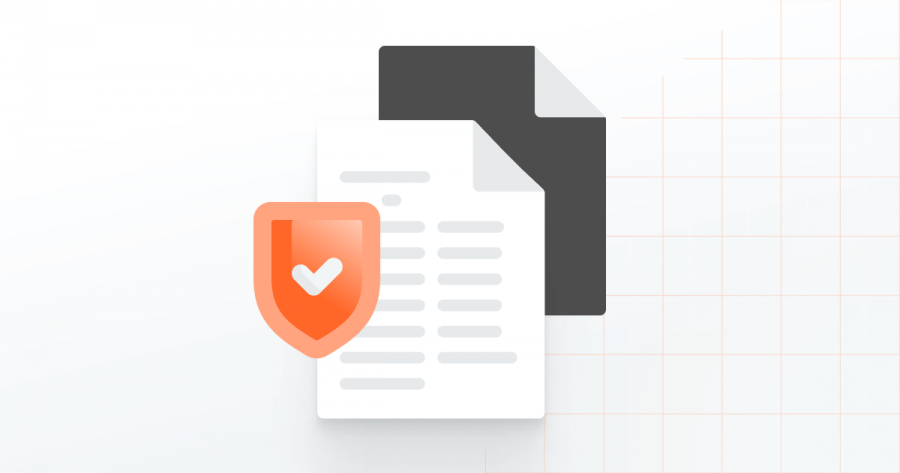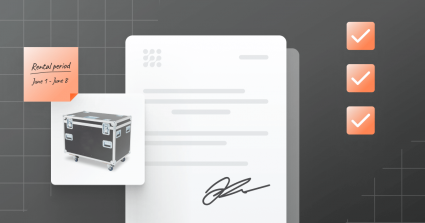Are you looking for an equipment rental agreement template?
Renting equipment is no small commitment. If you run a rental company, you already know how demanding it is to manage the wear and tear of your equipment.
You dedicate your time, crew, money, and potentially other resources toward renting equipment and trusting it will be handled correctly.
However, sometimes things don’t always go according to plan and as a result, your equipment can get damaged.
How do you decide on who has to cover the costs?
This discussion can create conflicts and arguments with your customers, which can be bad for business. To prevent strained relationships with them, it is important to make rental terms clear in a written agreement.
Here are answers to the questions you didn’t know you had about equipment rental agreements along with a free equipment rental agreement template to get you started.
I. What is an equipment rental agreement?
1. Definition
An equipment rental agreement (also known as an equipment rental form or an equipment rental contract) is a legally binding document that is used to rent equipment from one party to another for a fixed period of time.
Its purpose is to define in clear, thorough terms each party's responsibilities and obligations to protect the best interests of both parties, as neither can alter the agreement without prior written consent from the other.
This agreement includes terms such as the rental duration, rental rates, and instructions on how to use and return the equipment. Listing these terms on paper ensures that you and your customers are on the same page when it comes to handling your equipment.
2. Parties involved
No contract exists unless there are two or more parties agreeing to it. Hence, in an equipment rental agreement, the two main parties involved are the lessor and the lessee.
⚠️ Please note that “lessor” and “lessee” are legal terms, which is why they were used in this article. But, they can also be replaced by “provider”, “owner” and “renter” for example.

- The lessor
The lessor is the person or entity that owns the equipment and rents it to the other party under the rental agreement.
- The lessee
The lessee is the person or entity that rents the equipment from the provider. He/she must uphold specific obligations as defined in the rental agreement and by the governing law.
⚠️ A lessor and/or a lessee can either be a person or a business depending on the circumstance of the rental.
For example, you could own a small business that handles audiovisual equipment for companies in the event industry. Or, you could be planning an event and need to rent audio equipment (like speakers) from a friend.
3. When should an equipment rental agreement be used?
You should use an equipment rental agreement any time that you plan to rent equipment to someone.
If you are the lessor, you can use a rental agreement to protect your rights and make the lessee accountable for using your equipment in a responsible manner to help preserve its value.
If you are the lessee, you can also use this document if you plan to rent equipment from someone and if they are not providing a contract for you to sign.
4. What type of equipment can it be used for?
An equipment rental agreement can be used to outline the rental terms of a variety of equipment.
This includes:
- Audiovisual equipment (such as cameras, lights, projectors, microphones, DMX controllers, etc.),
- Staging equipment: (such as pipe and drapes, trusses, platforms, etc.),
- IT equipment (such as computers, monitors, hard drives, etc.),
- Party equipment (such as tents, tables, chairs, etc.).
II. What should an equipment rental agreement include?
The contents of an equipment rental agreement may vary from the type of industry and for the value of the equipment that is being rented.
Here is a list of elements you could consider including in your rental agreement:
1. Equipment subject to rent
Here you should include a clear description of the equipment that is being rented.
Your description should consist of:
- the name of the equipment,
- any attachments that it comes with,
- the quantity of each piece of equipment.
2. Rental rate
The rental rate states how much the lessee must pay to rent the equipment. This can be an hourly, daily, weekly, or monthly rate.
For example, if you rent out AV equipment to students, you may charge them an hourly rate. However, if you rent out AV equipment for long-term projects like a tour, you may charge a weekly/monthly rental rate.
3. Rental period
Every rental agreement starts with an agreed-on rental period. This period consists of the date from when a piece of equipment is rented out to the day it must be returned.
4. Care and operation
Here, you should outline instructions on how the lessee should operate and return the equipment.
For example, you can list key operating tips from the user manuals of the equipment that is being rented. You can also choose to mention who is authorized to use the rented equipment.
This helps to ensure that the lessee is using your equipment in a responsible manner to help preserve its value.
5. Indemnities
As you may know, when renting equipment, it is important to constantly inspect and repair your equipment to always keep it in good working condition.
In the event that your equipment malfunctions or an accident happens during the rental period, the lessee may want to seek reimbursement or file a lawsuit against you for damages. The conditions regarding these reimbursements can be listed under an indemnity clause.
Here, you can mention for example that the lessee cannot seek compensation or file a lawsuit against you for damages due to any accidents that occur while the equipment is rented.

6. Insurance coverage
When renting equipment, you can choose whether or not the lessee will need to purchase insurance or if it will be provided to them.
The insurance can be used to cover:
- loss or damage to the equipment itself,
- damage of property,
- injury to people while the equipment is being used in the case of unforeseen events.
Please note that this varies from region to region. Some states in the United States require insurance from the supplier. You should check your local laws to see if this applies to you.
We also wrote an article on how to turn your event rental documents from blah into fantastic that you might be interested in.
7. Transport
An equipment rental agreement should also include who is responsible for loading and transporting the equipment at the beginning and at the end of the rental period.
This can be either done by the lessor or the lessee. It is important to have this mentioned in your agreement to avoid having any misunderstandings with the other party.
III. Download our free equipment rental agreement template
Now that you know what an equipment rental agreement is and what it should consist of, here is a free template to get you started.
Equipment rental agreement template
You now have your own free template 🎉. Hooray! Nevertheless, we recommend that you continue reading to find out more about how you can save time and money when managing your rental equipment.
IV. How to manage your rental business more efficiently with Rentman
Managing an equipment rental business can be frustrating at times. From keeping track of your inventory and maintenance to communicating with your crew, and generating quotes for your clients. This list will keep growing the more your business grows.
Today, many companies use a combination of planning and communication tools including spreadsheets, phone calls, emails, and Word documents to help manage these tasks. However, working with this mix of tools can take up a lot of time and create issues that can have a major impact on your business.
Having a well-drafted equipment rental agreement is a great first step to protecting your company and equipment in case of damage or problems, but you should also consider using a dedicated cloud rental software to help you manage all of your rental tasks in a single platform to avoid losing any important information.
Rentman is a tailor-made software that helps you plan equipment, crew, and transport for a variety of events.
Not only does Rentman help track your resources but you can also create and customize documents like quotes, invoices, packing slips, subrental requests, and crew schedules on the go.
Start a free 30 day trial of Rentman to take your documents and planning to the next level.
Disclaimer: The content listed in an equipment rental agreement may vary depending on the country that you are residing in and the laws and regulations that apply there. Rentman will not be held responsible for any damages that you or any party might suffer as a result of using the template provided in this article.

